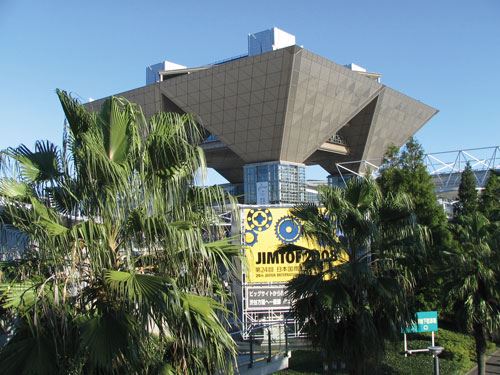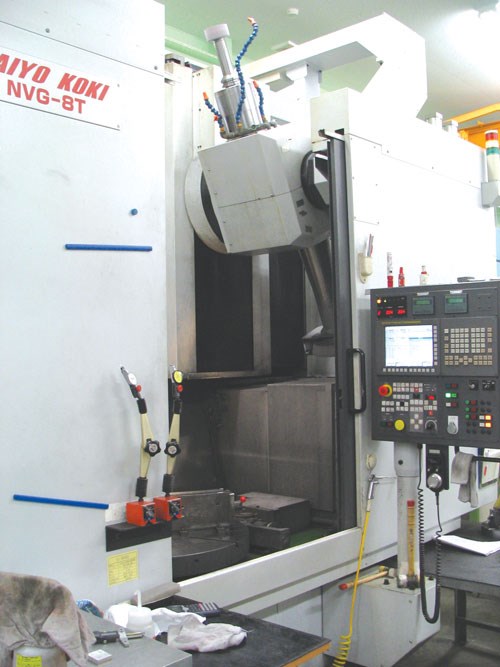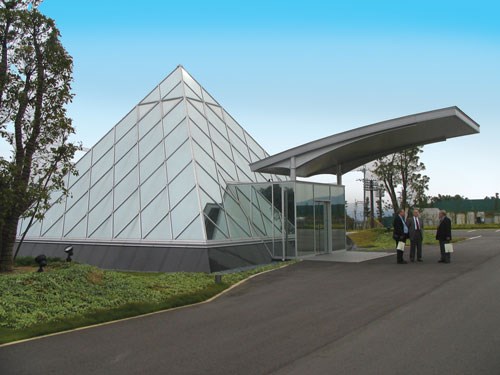JIMTOF Report: From the Field
The Japan International Machine Tool Fair (JIMTOF) is Japan’s most important machine tool show. The 2008 show reinforced the trends observed at the International Manufacturing Technology Show (IMTS) that took place in Chicago two months earlier. Along with a review of the show, this article summarizes editorial visits to two new machine tool factories. The report shows that Japan continues to be a dynamic force in machine design and construction.
Share





ECi Software Solutions, Inc.
Featured Content
View More




Autodesk, Inc.
Featured Content
View MoreFollowing our own International Manufacturing Technology Show (IMTS) by less than 2 months, JIMTOF used to set itself apart by being the event at which many of the Japanese machine tool builders previewed the technological advances under development for future machine tool models. These prototypes or "concept machines" presented a glimpse of new directions in machine design.
This is less true today. Most of the new machines on display at JIMTOF had been shown at IMTS or another recent show. Those not shown elsewhere were typically developed specifically for the machine tool market in Japan. No doubt the Japanese machine tool builders are still investing heavily in research and development, but these projects were not emphasized at JIMTOF. Nevertheless, it’s significant that many of the main trends noted at IMTS were also apparent at the show in Japan.
The mood at JIMTOF, however, was somewhat tempered by concerns over the turmoil in the financial sector, a crisis that had already flared up before IMTS. Both exhibitors and attendees said they were quite busy with jobs and orders already on the books, but long-term prospects were suddenly rather shaky. At any rate, worries about the economy did not keep crowds away—more than 50,000 attendees passed through the gates on the peak day of the show.
Big machines for big parts were well represented. Wind turbine components, frames for construction equipment, engine casings for power generation and parts for large airliners are still in demand, and more machines are needed to produce them. Builders promoted the rigidity, high torque and thermal stability of these machines. Full five-axis capability was the norm rather than the exception.
Machine features designed to conserve energy were also getting attention. Some of the energy-saving provisions on display included gas-charged cylinders instead of hydraulic systems; axis motors with inverters that allow power regeneration; control systems that automatically turn off electrical devices (pumps, lights, motors) when not needed; and gear boxes in spindle drives that allow smaller motors than those used in direct-drive systems to achieve equivalent speed and torque.
Environmental safety was often bundled with energy efficiency as a key end-user benefit. For example, minimum quantity lubrication (MQL), a technique to deliver a fine mist of coolant precisely aimed at the cutting tool/workpiece interface, was promoted by many exhibitors as an "eco-friendly" practice. One booth showed a new toolholder that served as a self-contained MQL dispenser. It operates without connection to a machine’s built-in coolant delivery system.
Another common theme was machine tool automation. "Minimum operator involvement" was the goal for the same reasons it’s getting a lot of attention state-side: Good operators are hard to find, and it’s essential to maximize their contribution to the overall productivity of a machining system. Add-ons or accessories such as robotic part handlers are more likely to be included when new equipment is ordered by Japanese shop managers than not, several exhibitors said. Automation is not an option—it’s a must.
Interestingly, the need for automation is reaching deep into machine design and machining strategy. For example, an HMC from one builder is designed to move the spindle, rather than the worktable, in three axes. This configuration keeps the workpiece still so that it is simpler for a gantry loader/unloader or robotic arm to find it. Likewise, shifting prismatic work to turn-mill machines with bar feeders to take advantage of built-in workhandling/fixturing automation is a popular strategy among shops in Japan.
A remarkable number of machines from Japan claim accuracy to ±1 micron or less. Some builders stress that relying on traditional means of achieving such accuracy is a foundation upon which other strategies rest. Thus, they insist on hand-scraping ways and other critical surfaces. Another major focus is on controlling heat effectively. For example, thermally symmetrical machine structures help avoid distortions that occur when heat spreads unevenly. Isolating sources of heat from the rest of the machine is another design consideration. Removing heat that does get through by circulating chilled coolant is another option, as is compensating for its effects electronically by responding to sensor feedback.
A glance at the many cutting tool suppliers at JIMTOF finds small tools proliferating. One company showed a 0.01-mm-diameter end mill as a standard item, not as a special, indicating that prices are going down and availability is going up. Another company showed a 0.5-mm drill with a coolant hole in the center for work on diesel engine injection nozzles.
At Tokyo’s Big Sight exhibition center, JIMTOF is an intense experience in an austere yet harmonious setting. No one catches all of the subtleties in the technology on display there. In short, the show is characteristically Japanese.
A Well-Grounded Factory
While in Japan, MMS visited two new machine tool plants that are among the most modern in the world. One is "hidden" underground. The other wants to be less of a secret outside Japan.
The most remarkable fact about the Mazak Optonics plant in Minokamo (on the outskirts of Nagoya) is that the factory is almost entirely underground. Optonics, owned by Yamazaki Mazak Corp. (Oguchi, Japan), builds 2D and 3D laser cutting machines. Named the Phoenix Laboratory, the plant was completed in the third quarter of 2008. It is very near the parent company’s Minokamo Plants 1 and 2, both of which were completed in the last 10 years and are still models of machine tool construction.
The laser cutting machines produced by Optonics incorporate many delicate components, such as lenses and mirrors, that must be kept very clean during assembly. Therefore, a building to house this critical work must provide an environment sealed against dust and contamination from the outside. This means no windows, few doors and thorough insulation. Planners recognized that building underground would provide a natural barrier against dirt, dust, heat and vibration. Fortunately, the construction site’s sloping terrain greatly reduced the excavation required to achieve the desired effect.
The finished building, which lies beneath a grassy field next to the parking lot for employees and visitors, is essentially a 100,000-square-foot "clean room" where the number of measurable dust particles is a fraction of the number found in the company’s previous facility. Because the building is very much like a cave (albeit roomy and well lit), the temperature inside remains very steady. Its climate control system needs only 20 percent of the capacity that a typical factory of the same size would need. Another benefit is the amount of green space that remains above to meet environmental codes.
Visitors and employees (230 work in the plant) enter via modernistic, above-ground vestibules. Down below, the assembly bays do not look much different from those in other large factories, although the roof trusses on the ceiling are sturdier to support the additional weight above. Amenities include offices, meeting rooms, training areas and a cafeteria. All hot food served there is catered—a kitchen would create too much heat. Much of the décor in these areas features laser-cut components produced on the company’s own machines.
These machines are designed for high speed, multi-axis cutting of sheet and pipe into complex geometries that require exceptional accuracy. At this plant, the frames and gantries (manufactured at another facility) are asembled with the beam delivery systems. The control units, linear motors and mirrors are also manufactured here. Final assembly commences as orders are received and takes about 2 weeks.
Trying To Stand Out
Taiyo Koki’s main factory in Nagaoka is very much aboveground and quite obviously a new building—it was completed just over 3 years ago. The company builds all of its grinding machines here, including its distinctive line of vertical grinders. Yet visibility is an issue. Neither the company’s identity nor its technology get the notice that Noboru Watanabe, company president, believes it deserves, but he is working to correct that. Since becoming a subsidiary of Mori Seiki (Nagoya, Japan) in 2001, Taiyo Koki’s machines have been prominently displayed at major machine tool shows around the world, including IMTS and JIMTOF.
At JIMTOF, the company introduced its NVGH-10C model. This CNC vertical multi-purpose grinding machine is designed for ID, OD and face grinding of large workpieces. It is also capable of cam profile grinding and index grinding couplings in one setup. The most noticeable feature of this machine is the front-mounted grinding spindle turret. The ID and OD grinding spindles are stationed on opposite sides of the turret, which rotates them into position to switch grinding modes automatically. The workpiece table is mounted vertically in the machine base, an orientation that takes advantage of gravity. Because the workpiece stands upright, its weight does not deflect on the turntable as it might in a horizontal spindle chuck. The mass of the workpiece allows it to be held with less gripping force, too, so it is less likely to be deformed.
Mr. Watanabe is especially eager to promote the concept of vertical grinding to U. S. bearing manufacturers that produce large components for wind turbines and similar applications. The new machine is produced at the main plant, where machining of grinder bases, columns and beams takes place in one bay and final assembly in another. Taiyo Koki makes its own spindles in this plant as well.
Related Content
How to Successfully Adopt Five-Axis Machining
While there are many changes to adopt when moving to five-axis, they all compliment the overall goal of better parts through less operations.
Read MoreHow to Determine the Currently Active Work Offset Number
Determining the currently active work offset number is practical when the program zero point is changing between workpieces in a production run.
Read MoreWhere Micro-Laser Machining Is the Focus
A company that was once a consulting firm has become a successful micro-laser machine shop producing complex parts and features that most traditional CNC shops cannot machine.
Read MoreOrthopedic Event Discusses Manufacturing Strategies
At the seminar, representatives from multiple companies discussed strategies for making orthopedic devices accurately and efficiently.
Read MoreRead Next
Building Out a Foundation for Student Machinists
Autodesk and Haas have teamed up to produce an introductory course for students that covers the basics of CAD, CAM and CNC while providing them with a portfolio part.
Read MoreRegistration Now Open for the Precision Machining Technology Show (PMTS) 2025
The precision machining industry’s premier event returns to Cleveland, OH, April 1-3.
Read More5 Rules of Thumb for Buying CNC Machine Tools
Use these tips to carefully plan your machine tool purchases and to avoid regretting your decision later.
Read More















.png;maxWidth=150)




















.jpg;maxWidth=300;quality=90)











.jpg;maxWidth=300;quality=90)







